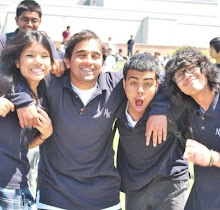That's what we would be saying if the geniuses of science didn't engineer a weedy grass found in central America into the beloved corn that we have today. 10,000 years ago, our ancestors never had the golden pleasure of corn! By artificial selection, we engineered teosinte into corn. So how does one do this? A stalk of teosinte, has variations. Some are tall, some are short, fat while some are skinny, and some have plump seeds and some has itty bitty ones. Some smart person though "What do I want to eat next year?". Genes are then taken from crop that have the desirable traits and the process if repeated generation after generation until VOILA, masterpiece.

After looking at this picture of teosinte, I've never been so grateful for science in my life.
And take a look at wild tomatoes (right) and domestic ones (left)

Artificial selection in plants is wonderful, though we do risk them being wiped out by diseases or environmental factors. Since they lack variation, they're all in the same boat which may lead to survival or doomsday ( So dramatic...). I think designing our fruits and veggies is still a good gamble. Can you imagine having those tomatoes in your salad? Yuck!
Now let's talk about artificial selection in animals. A study was done in Pushkinskoe Fur Farm in Mo
 scow, where over the course of 41 years they experimented on sables. In the wild, they are usually found with furs that vary from a sandy yellow to dark brown. Dark brown, black, or blue-black fur is considered the most valuable. From this study, they concluded that artificial selection aimed to change characteristics unrelated to fitness has a co-relation to the decrease of the animal's fitness.
scow, where over the course of 41 years they experimented on sables. In the wild, they are usually found with furs that vary from a sandy yellow to dark brown. Dark brown, black, or blue-black fur is considered the most valuable. From this study, they concluded that artificial selection aimed to change characteristics unrelated to fitness has a co-relation to the decrease of the animal's fitness. Of course, cows, pigs, chickens and other produce are genetically enhanced to be bigger, meatier, and produce more. The question is, is it okay to do that to them, knowing they suffer the consequences? Well this can branch out to two point of views:
-No! These animals deserve a good quality of life too. Animal rights is important, especially in a world where we rely on them so much.
-Yes, they are going to get slaughtered for meat anyway and live in a domestic environment. it's not like they're in the wild, fending for themselves with their less-than-efficient fitness.
Though i thought of both of these points myself, I believe in my second one a more. (Animal rights activists, I'm looking forward to your angry letters). Yes, I understand it's a pretty morbid point of view but farmers need to have the best produce, it's our dinner but their livelihood that they are controlling.
But what if people are artificially selecting to make perfect domestic animals? The video "Artificial Selection: Creating the perfect pet" introduced in unit 8 was terrifyingly creepy. In the video, Brian Simison, the head of The Center of Comparative Genomics said that when owners strive to make pure breeds, it results in overlapping genes which can be recessive. Cavalier Spaniards can get syringomyelia which causes them a lot of pain, yet they win contests for their owners. Now that's just mean. I believe that artificially "enhancing" an animal to win it's owner prize money in dog contests is cruel. I say to those dog breeders, go get a real job.
Work cited
http://resources.metapress.com/pdf-preview.axd?code=24827621n282n824&size=largest
http://evolution.berkeley.edu/evolibrary/news/070201_corn
http://www.sable-pro.net/rl-sable.jpg
